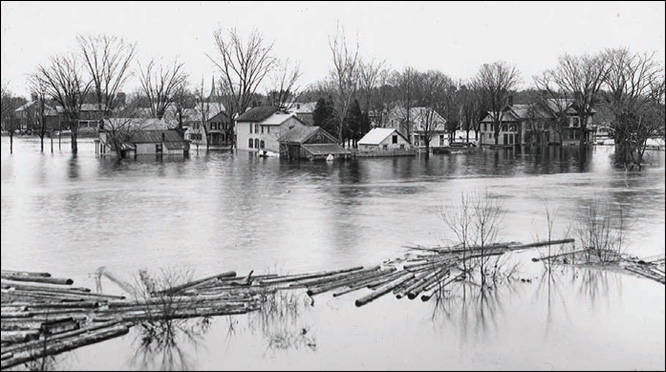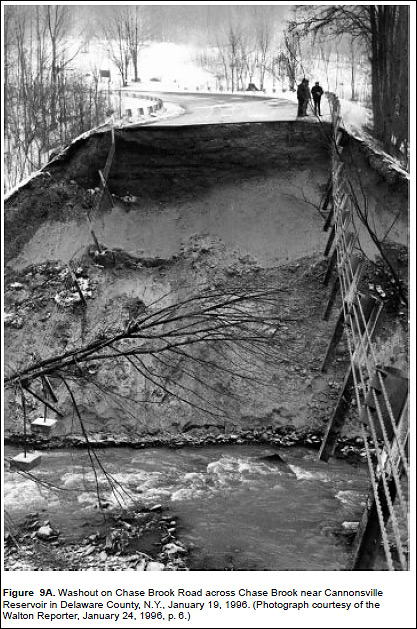
On this page, you will learn what types of flooding are typical in New York and how to protect yourself, your family and your home. You can also find out more about significant New York floods. Finally, you'll find links to NWS offices that provide forecast and safety information for New York as well as links to our partners who play a significant role in keeping you safe.
Back-to-back hurricanes, Connie and Diane struck southeast New York in August of 1955. According to the US Weather Bureau monthly flood report for the Albany, NY station, the village of Windham, NY, experienced a flash flood on Catskill Creek as a result of rainfall associated with Hurricane Connie. In general, Connie chiefly served to saturate soils and end a summer-long drought in New York. For example, the 15.15 inches of rain that fell at Slide Mountain, NY, from August 11 to 14 brought the Esopus Creek only up to 12 feet. By contrast, Hurricane Diane brought 5.90 inches of rain to Slide Mountain August 18th-19th, which resulted in disastrous small stream flooding in the Catskills.
Severe flooding in southeastern New York from Diane was limited mostly to a narrow band from the vicinity of Poughkeepsie to Port Jervis. The Hudson and Mohawk Rivers did not reach flood stage but major to unprecedented flooding occurred in Rondout Creek and Wallkill River basins on the west side of the Hudson. The greatest devastation occurred at the confluence of Beer Kill, Fantine Kill and Mountain Brook with Sandburg Creek in the village of Ellenville where 500 people were driven from their homes; of these, 200 had to be evacuated. Seven homes were demolished along Beer Kill Creek. All previous flood peaks were exceeded on the Wallkill River. Damage was limited mostly to crops and highway flooding from Middletown northward. Wappinger Creek, near Wappingers Falls, NY, exceeded the all-time high stage reached during the hurricane flood of September 1938. Severe flooding occurred through its entire course. The flood in the Neversink River, a tributary of the Delaware in New York, also exceeded previous flood records.
In New York, four deaths were reported associated with the flooding and the Corps of Engineers estimated Diane caused $17.8 million in damages (in 1955 dollars).
Excerpts used from: Weather Bureau Technical Paper No. 26: Hurricane Rains and Floods of August 1955, Carolinas to New England, published April 1956 by the US Government Printing Office.
Learn More:
Unlike some other flood producing hurricanes in the northeast, Agnes was not a particularly strong hurricane. In fact, most of its devastation occurred well after the Agnes had been downgraded to a tropical storm. Agnes originated in the Gulf of America and slowly moved up the east coast before moving northwest across Pennsylvania and the southern tier of New York. At this point, the remnants of Agnes joined another large low pressure system and continued to produce heavy rains. During the week prior to Agnes, a large amount of shower activity resulted in widespread areas of over an inch of rain. Heavy rain from Agnes started on the night of June 20 and continued until the June 23.
Flooding from Agnes affected the Chemung, Susquehanna, Delaware and Genesee River basins in New York. The flooding in New York alone resulted in 24 deaths and damages of approximately $703 million (in 1972 dollars). The Chemung River Basin was particularly hard hit with record flooding. Some river points along the Chemung River broke previous records by over 7 feet. Elmira and Corning were devastated; both cities saw water over their levees and hundreds of homes and businesses inundated. The 24 deaths in New York occurred in Corning.
 |
| Map of rainfall from Hurricane Agnes from Northeast River Forecast Center |
Learn More:
A major flood event occurred on January 19-20, 1996, as a result of rapid meltdown of snowpack along with 2-4 inches of rain. Record flooding occurred on Schoharie Creek as well as significant flooding on Mohawk River at Schenectady and on the Hudson at Albany (15.5 feet - greatest flood peak since New Year’s 1949). The Susquehanna and Delaware river basins also suffered from major flooding, widespread evacuations, and catastrophic damage to infrastructure throughout the valleys. At least nine deaths were attributed to the flood event in New York, including six victims who died when a pond dam collapsed in Delaware County.
From United States Geological Survey Water Resources Investigations Report 97-4252:
Damage to highways, bridges, and private property exceeded $100 million (Federal Emergency Management Agency, 1997). The storm and flooding claimed 10 lives, stranded hundreds of people, destroyed or damaged thousands of homes and businesses, and closed hundreds of roads. Forty-one counties in New York were declared Federal disaster areas. The most severely affected region was within and surrounding the Catskill Mountains in southeastern New York. Damages and losses within Delaware County alone exceeded $20 million.
The more than 4.5 inches of rain that fell on the Catskill Mountain region during January 18-19, combined with melting of as much as 45 in. of snow, resulted in major flooding throughout the region. Other areas of the state also underwent major flooding as a result of similar conditions. Ice and debris contributed to the flooding where they became jammed at culverts, bridges, and natural constrictions within stream channels. The most destructive flooding was along Schoharie Creek and the East and West Branches of the Delaware River in southeastern New York. Record peak discharges occurred at 57 U.S. Geological Survey (USGS) streamflow-gaging stations throughout New York. Peak discharges at 15 sites had recurrence intervals equal to or greater than 100 years. Most sites at which these peak discharges occurred were within the Schoharie Creek and Delaware River basins. Reservoirs throughout New York, particularly those within the Catskill Mountain region, stored large amounts of floodwater, and, thus, sharply reduced peak discharges downstream.
 |
| Photo as included in USGS Water Resources Investigations Report 97-4252 |
Learn More:
On Tuesday, June 27, a frontal boundary stalled across the region. The boundary extended from southern Quebec across central New York and to Florida. A weak disturbance of tropical origin moved through southeast New York on the morning of June 28, yielding additional tropical moisture. A strong low level jet developed which transported tropical moisture into central and eastern New York. This low resulted in 3 days (June 26-28) of warm rain over the western Mohawk, Susquehanna and Delaware river basins. Estimated rainfall amounts are mapped below, but generally ranged from 2 to 6 inches, with amounts between 11 and 13 inches reported in the high peaks of the Catskills.
Record flooding occurred on the western Mohawk at East Canada Creek, the Canajoharie Creek, and on the Mohawk River at Little Falls. The NYS Thruway, main rail line and many towns along the Mohawk River were under water and numerous mudslides were reported. Devastating flash, and river flooding also struck the Susquehanna and Delaware basins with many gauge locations breaking their previous record high stages and flows. Thirteen counties were declared disaster areas, and two Interstate 88 bridges were destroyed near Sidney, NY.
From USGS Open File Report 2009-1063:
The storm and flooding claimed four lives in New York, destroyed or damaged thousands of homes and businesses, and closed hundreds of roads and highways. Thousands of people evacuated their homes as floodwaters reached new record elevations at many locations within the three basins.... Disaster-recovery assistance for individuals and businesses adversely affected by the floods of June 2006 reached more than $227 million.
Learn More:
|
||||||